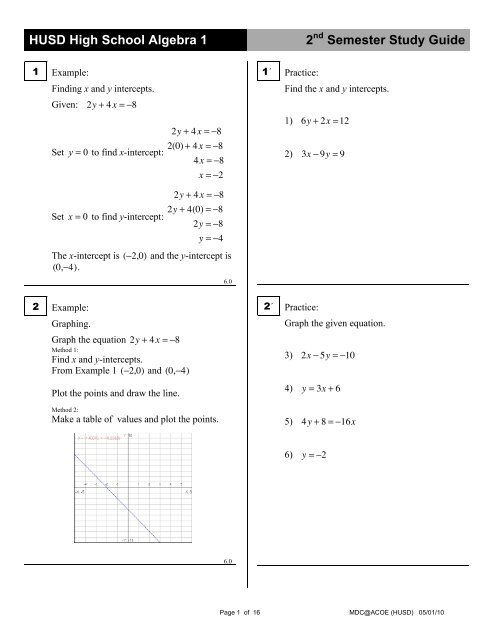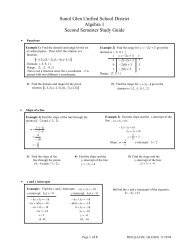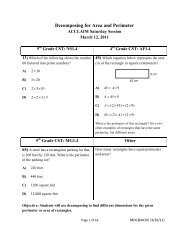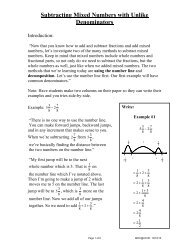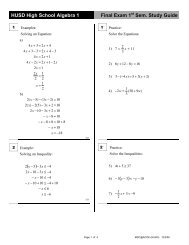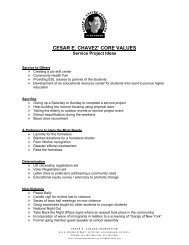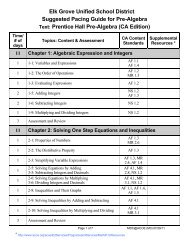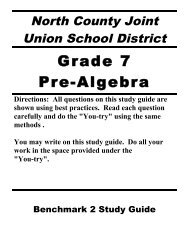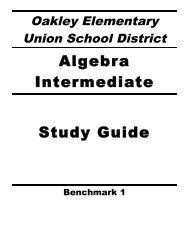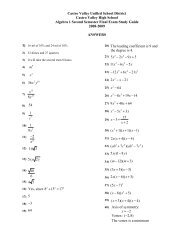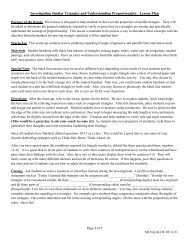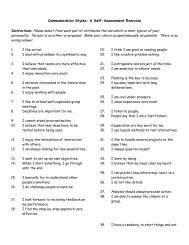HUSD High School Algebra 1 2nd Semester Study Guide
HUSD High School Algebra 1 2nd Semester Study Guide
HUSD High School Algebra 1 2nd Semester Study Guide
- No tags were found...
You also want an ePaper? Increase the reach of your titles
YUMPU automatically turns print PDFs into web optimized ePapers that Google loves.
<strong>HUSD</strong> <strong>High</strong> <strong>School</strong> <strong>Algebra</strong> 1<br />
2 nd <strong>Semester</strong> <strong>Study</strong> <strong>Guide</strong><br />
1 Example:<br />
Finding x and y intercepts.<br />
Given: 2y + 4x = −8<br />
Set y = 0 to find x-intercept:<br />
Set x = 0 to find y-intercept:<br />
2y + 4x = −8<br />
2(0) + 4x = −8<br />
4x = −8<br />
x = −2<br />
2y + 4x = −8<br />
2y + 4(0) = −8<br />
2y = −8<br />
y = −4<br />
1´ Practice:<br />
Find the x and y intercepts.<br />
1) 6y + 2x =12<br />
2) 3x − 9y = 9<br />
The x-intercept is (−2,0) and the y-intercept is<br />
(0,−4).<br />
6.0<br />
2 Example:<br />
Graphing.<br />
Graph the equation 2y + 4x = −8<br />
Method 1:<br />
Find x and y-intercepts.<br />
From Example 1 (−2,0) and (0,−4)<br />
Plot the points and draw the line.<br />
Method 2:<br />
Make a table of values and plot the points.<br />
2´ Practice:<br />
Graph the given equation.<br />
3) 2x − 5y = −10<br />
4) y = 3x + 6<br />
5) 4y + 8 = −16x<br />
6) y = −2<br />
6.0<br />
Page 1 of 16 MDC@ACOE (<strong>HUSD</strong>) 05/01/10
<strong>HUSD</strong> <strong>High</strong> <strong>School</strong> <strong>Algebra</strong> 1<br />
2 nd <strong>Semester</strong> <strong>Study</strong> <strong>Guide</strong><br />
3 Example:<br />
Slope = rise change in the y − coordinate<br />
=<br />
run change in the x − coordinate<br />
Horizontal Line:<br />
Find the slope of<br />
The line through<br />
Vertical Line:<br />
Find the slope of<br />
the line through<br />
(2,3) and (−1,3) (−2,−1) and (−2,3)<br />
m =<br />
=<br />
change in y<br />
change in x<br />
3− (3)<br />
−1− (2)<br />
m =<br />
=<br />
change in y<br />
change in x<br />
3− (−1)<br />
−2 − (−2)<br />
3´ Practice:<br />
Write the equation of the line in standard<br />
form:<br />
7) Find the equation of the line passing<br />
through the point ( 1, 5 ) with a slope of<br />
m = 0.<br />
8) Find the equation of the line passing<br />
− 1,4 with undefined<br />
through the point ( )<br />
slope (or no slope).<br />
= 0 −3<br />
= 4 0<br />
Slope is m = 0 Since division by 0<br />
is not defined, this<br />
Equation is y = 3 line has no slope or<br />
undefined slope.<br />
Equation is x = −2<br />
7.0<br />
Page 2 of 16 MDC@ACOE (<strong>HUSD</strong>) 05/01/10
<strong>HUSD</strong> <strong>High</strong> <strong>School</strong> <strong>Algebra</strong> 1<br />
2 nd <strong>Semester</strong> <strong>Study</strong> <strong>Guide</strong><br />
4 Example:<br />
Write an equation in slope-intercept form of<br />
the line passing through the point (6,−3) with<br />
slope m = 2.<br />
Use the point-slope form of a line, m is the<br />
slope and (x 1<br />
, y 1<br />
) = (6,−3)<br />
y − y 1<br />
= m(x − x 1<br />
)<br />
y − (−3) = 2(x − 6)<br />
y + 3 = 2x −12<br />
y + 3− 3 = 2x −12 − 3<br />
y = 2x −15<br />
4´ Practice:<br />
Write the equation of the line in<br />
slope-intercept form.<br />
9) line passes through (0,−5) and (3,4)<br />
10) line passes through (−3,1) and (5,5)<br />
For constants a and b:<br />
y = b is a horizontal line with slope m = 0<br />
x = a is a vertical line with no slope or<br />
undefined slope.<br />
7.0<br />
5 Example:<br />
Finding parallel and perpendicular slopes.<br />
The slope of line l is −2 which also can be<br />
written m = −2<br />
A line parallel to line l has the same slope so<br />
m = m = −<br />
1<br />
2<br />
A line perpendicular to line l has the slope<br />
m 2<br />
such that m⋅<br />
m2 = −1.<br />
m⋅<br />
m<br />
2<br />
−2⋅<br />
m = −1<br />
2<br />
−2⋅m<br />
−2<br />
m<br />
2<br />
2<br />
= −1<br />
= − 1<br />
−2<br />
1<br />
=<br />
2<br />
Perpendicular slopes are opposite reciprocals.<br />
8.0<br />
5´ Practice:<br />
Line k is given by the equation 2x + 6y =12.<br />
11) Find the slope of the line parallel to<br />
line k.<br />
12) Find the slope of the line perpendicular<br />
to line k.<br />
13) Write the equation of the line that passes<br />
through the point ( −2,5) and is<br />
perpendicular to line k.<br />
Page 3 of 16 MDC@ACOE (<strong>HUSD</strong>) 05/01/10
<strong>HUSD</strong> <strong>High</strong> <strong>School</strong> <strong>Algebra</strong> 1<br />
2 nd <strong>Semester</strong> <strong>Study</strong> <strong>Guide</strong><br />
6 Examples:<br />
Solving Equations by Factoring.<br />
a)<br />
( v + 7) ( v − 3) = 0<br />
( v + 7) = 0 or ( v − 3) = 0<br />
v = −7 or v = 3<br />
b)<br />
2x 2 +10x = 0<br />
2x(x + 5) = 0<br />
2x = 0 or (x + 5) = 0<br />
x = 0 or x = −5<br />
6´ Practice:<br />
Solve the equation by factoring.<br />
14) ( x −1) ( x + 6) = 0<br />
15)<br />
1<br />
z<br />
3<br />
2<br />
+ 5z<br />
= 0<br />
2<br />
16) 12m<br />
+ 4m<br />
= 40<br />
c)<br />
18n 2 − 27n = −9<br />
18n 2 − 27n + 9 = 0<br />
9(2n 2 − 3n +1) = 0<br />
9(2n −1)(n −1) = 0<br />
(2n −1) = 0 or (n −1) = 0<br />
2n =1<br />
n = 1 2<br />
or n =1<br />
14.0<br />
Page 4 of 16 MDC@ACOE (<strong>HUSD</strong>) 05/01/10
<strong>HUSD</strong> <strong>High</strong> <strong>School</strong> <strong>Algebra</strong> 1<br />
2 nd <strong>Semester</strong> <strong>Study</strong> <strong>Guide</strong><br />
7 Example:<br />
Solve the system x − y = −4<br />
by graphing.<br />
y = −2x<br />
− 2<br />
1 st Graph x − y = −4 by finding intercepts.<br />
a. Use a table to find the intercepts.<br />
7´ Practice:<br />
Solve the system of equations by graphing.<br />
Check your solution algebraically by<br />
substituting the ordered pair in each equation<br />
to make sure it gives you a true statement in<br />
each equation.<br />
x x − y = −4 y<br />
0 0 − y = −4 4<br />
−y = −4<br />
−1(−y) = −1(−4)<br />
y = 4<br />
– 4 x − 0 = −4<br />
0<br />
x = −4<br />
b. Plot the intercepts (0,4) and (−4,0).<br />
c. Graph the line. (see graph below)<br />
2 nd Graph y = −2x<br />
− 2 using slope-intercept<br />
form y = mx + b .<br />
17)<br />
18)<br />
x + y = −4<br />
y = −2x + 5<br />
x − y = 5<br />
2x + 3y = 0<br />
a. Identify the slope m = − 2 1<br />
b. Identify the y-intercept 0,−2 ( )<br />
c. Plot ( 0,−2), go down two units and right<br />
one unit and plot a point. Graph the line.<br />
3 rd Locate the point of intersection of the<br />
lines.<br />
( ) is the solution to the system<br />
∴ −2,2<br />
x − y = −4<br />
y = −2x<br />
− 2 check algebraically! 9.0<br />
Page 5 of 16 MDC@ACOE (<strong>HUSD</strong>) 05/01/10
<strong>HUSD</strong> <strong>High</strong> <strong>School</strong> <strong>Algebra</strong> 1<br />
2 nd <strong>Semester</strong> <strong>Study</strong> <strong>Guide</strong><br />
8 Example:<br />
Solve the system of equations by the<br />
Substitution Method.<br />
Solve the system: 3 x + y = 5<br />
2x<br />
− y = 10<br />
1 st Solve for one variable (y in equation 1)<br />
3x<br />
+ y = 5<br />
3x + y − 3x = 5−<br />
3x<br />
y = 5−<br />
3x<br />
or y = − 3x<br />
+ 5<br />
2 nd Substitute − 3x + 5 for y in equation 2<br />
2x − (−3x + 5) =10<br />
3 rd Solve for x.<br />
2x − (−3x + 5) =10<br />
2x + 3x − 5 =10<br />
5x − 5 =10<br />
5x − 5 + 5 =10 + 5<br />
5x =15<br />
x = 3<br />
4 th Substitute x = 3 into y = − 3x<br />
+ 5 to solve<br />
for y.<br />
y = −3(3) + 5<br />
y = −9 + 5<br />
y = −4<br />
∴ ( 3,−4 ) is the solution to the system<br />
3x<br />
+ y = 5<br />
2x<br />
− y = 10<br />
8´ Practice:<br />
Solve the system of equations by the<br />
Substitution Method.<br />
19)<br />
20)<br />
−2x + 4y = −16<br />
x + 6y = −16<br />
y = 6x − 4<br />
y = −2x + 28<br />
9.0<br />
Page 6 of 16 MDC@ACOE (<strong>HUSD</strong>) 05/01/10
<strong>HUSD</strong> <strong>High</strong> <strong>School</strong> <strong>Algebra</strong> 1<br />
2 nd <strong>Semester</strong> <strong>Study</strong> <strong>Guide</strong><br />
9 Example:<br />
Solve the system by the Elimination Method.<br />
9´ Practice:<br />
Solve the system of equations by using the<br />
Elimination Method.<br />
Solve the system:<br />
2x − y =1<br />
3x + 2y =12<br />
1 st Rewrite the equations so they have<br />
opposite terms. Multiply equation 1 by 2 so<br />
that −2y and 2y are opposites.<br />
2( 2x<br />
− y) = 2( 1)<br />
3x<br />
+ 2y<br />
= 12<br />
4x<br />
− 2y<br />
= 2<br />
3x<br />
+ 2y<br />
= 12<br />
2 nd Add vertically: 7x<br />
+ 0y<br />
= 14<br />
3 rd Solve for x:<br />
7x<br />
= 14<br />
x = 2<br />
4 th Solve for y by choosing one of the<br />
equations and substituting x = 2:<br />
3(2) + 2y =12<br />
6 + 2y − 6 =12 − 6<br />
2y = 6<br />
y = 3<br />
∴ ( 2,3) is the solution to the system<br />
2x − y =1<br />
3x + 2y =12<br />
9.0<br />
21)<br />
22)<br />
3x + 4y = 46<br />
−2x − 2y = −28<br />
3x + 2y = −9<br />
−10x + 5y = −5<br />
Page 7 of 16 MDC@ACOE (<strong>HUSD</strong>) 05/01/10
<strong>HUSD</strong> <strong>High</strong> <strong>School</strong> <strong>Algebra</strong> 1<br />
2 nd <strong>Semester</strong> <strong>Study</strong> <strong>Guide</strong><br />
10 Example:<br />
Solving a Coin Problem using a system of<br />
equations.<br />
Alyssa has 25 coins that total $3.55. If she<br />
has only dimes and quarters, how many dimes<br />
does she have<br />
Let d = number of dimes<br />
Let q = number of quarters<br />
1 st Write two equations:<br />
Equation for the total number of coins:<br />
d + q = 25<br />
10´ Practice:<br />
Solve the following problem using a system<br />
of equations.<br />
23) A vending machine takes only nickels<br />
and dimes. At the end of the day there were<br />
three times as many nickels as dimes and a<br />
total of $25.00 in the machine. How many<br />
of each coin were there in the machine<br />
Equation for the total amount of money:<br />
0.10d + 0.25q = 3.55<br />
Now, the system of equations is:<br />
d + q = 25<br />
0.10d + 0.25q = 3.55<br />
2 nd Solve the system by the elimination<br />
method:<br />
Multiply equation 1 by −10 and multiply<br />
equation 2 by 100 to clear the decimals.<br />
−10d −10q = −250<br />
10d + 25q = 355<br />
Adding vertically gives the equation<br />
15q =105<br />
q = 7<br />
(solve for q)<br />
Choosing d + q = 25 and substituting q = 7<br />
Results in the following:<br />
d + q = 25<br />
d + 7 = 25<br />
d + 7 − 7 = 25 − 7<br />
d =18<br />
3 rd Answer the question: Alyssa has 18<br />
dimes.<br />
9.0<br />
Page 8 of 16 MDC@ACOE (<strong>HUSD</strong>) 05/01/10
<strong>HUSD</strong> <strong>High</strong> <strong>School</strong> <strong>Algebra</strong> 1<br />
2 nd <strong>Semester</strong> <strong>Study</strong> <strong>Guide</strong><br />
11 Examples:<br />
Simplifying Radical Expressions.<br />
a)<br />
28<br />
9<br />
11´ Practice:<br />
Simplify.<br />
24)<br />
16<br />
⋅ 44 ⋅ 11<br />
64<br />
b)<br />
c)<br />
d)<br />
= 28 9<br />
= 22 ⋅ 7<br />
3 2<br />
= 2 7<br />
3<br />
18m 2 n 3 p 6<br />
= 3 2 ⋅ 2m 2 n 2 n( p 3<br />
) 2<br />
= 3mnp 3 2n<br />
=<br />
8x<br />
3x 3<br />
8x<br />
3x 3<br />
= 22 ⋅ 2<br />
3x 2 ⋅ 3 3<br />
= 22 ⋅ 2 ⋅ 3<br />
3 2 x 2<br />
= 2 6<br />
3x<br />
2 12 − 27 + 36<br />
25) − 3 7<br />
26) 48p 11 q 4<br />
27) −11 8 + 7 18 + 2 50<br />
= 2 2 2 ⋅ 3 − 3 2 ⋅ 3 + 6 2<br />
= 2 ⋅ 2 3 − 3 3 + 6<br />
= 4 3 − 3 3 + 6<br />
= 3 + 6<br />
2.0<br />
Page 9 of 16 MDC@ACOE (<strong>HUSD</strong>) 05/01/10
<strong>HUSD</strong> <strong>High</strong> <strong>School</strong> <strong>Algebra</strong> 1<br />
2 nd <strong>Semester</strong> <strong>Study</strong> <strong>Guide</strong><br />
12 Examples.<br />
Solving Quadratic Equations.<br />
Solve by finding square roots.<br />
a)<br />
5y 2 −16 = 0<br />
5y 2 =16<br />
Solve for<br />
2<br />
y<br />
12´ Practice.<br />
Solve by finding square roots.<br />
28) ( x − 2) 2 = 49<br />
29) 3x 2 − 25 = 0<br />
y 2 = 16 5<br />
y = ± 16 5<br />
y = ± 4 5<br />
y = ± 4 5 ⋅ 5<br />
5<br />
y = ± 4 5<br />
5<br />
Solve by factoring.<br />
b)<br />
3w 2 + 5w = 2<br />
3w 2 + 5w − 2 = 0<br />
( 3w −1) ( w + 2) = 0<br />
3w −1 = 0 or w + 2 = 0<br />
Solve for y<br />
Rationalize<br />
the<br />
denominator<br />
Rewrite the<br />
equation in<br />
standard<br />
form<br />
Factor<br />
Zero Product<br />
Property<br />
Solve each<br />
equation<br />
Solve by factoring.<br />
30) 3( x + 6) ( x −1) = 0<br />
31) 4x 2 +12x = 7<br />
w = 1 3 or w = −2 14.0<br />
Page 10 of 16 MDC@ACOE (<strong>HUSD</strong>) 05/01/10
<strong>HUSD</strong> <strong>High</strong> <strong>School</strong> <strong>Algebra</strong> 1<br />
2 nd <strong>Semester</strong> <strong>Study</strong> <strong>Guide</strong><br />
13 Examples.<br />
Solving Quadratic Equations.<br />
Solve by Completing the Square.<br />
a)<br />
x 2 + 8x +12 = 0<br />
⎛<br />
x 2 + 8x + 8 ⎞<br />
⎜ ⎟<br />
⎝ 2⎠<br />
x 2 + 8x = −12<br />
2<br />
⎛<br />
= −12 + 8 ⎞<br />
⎜ ⎟<br />
⎝ 2⎠<br />
x 2 + 8x + 4 2 = −12 +16<br />
( x + 4) ( x + 4) = 4<br />
( x + 4) 2 = 4<br />
x + 4 = ± 4<br />
x = −4 ± 2<br />
x = −4 + 2 or x = −4 − 2<br />
x = −2 or x = −6<br />
Solve by using the quadratic formula.<br />
b)<br />
3x 2 − 4x − 2 = 0<br />
a = 3, b = −4, c = −2<br />
x = −b ±<br />
x = − −4<br />
x =<br />
b2 − 4ac<br />
2a<br />
( ) ± −4<br />
2( 3)<br />
4 ± 16 + 24<br />
6<br />
x = 4 ± 40<br />
6<br />
x = 4 ± 2 10<br />
6<br />
x = 4 6 ± 2 10<br />
6<br />
x = 2 3 ± 10<br />
3<br />
x = 2 ± 10<br />
3<br />
( )2 − 4 3<br />
( )( −2)<br />
2<br />
Isolate<br />
2<br />
x and x<br />
Add half the linear<br />
coefficient<br />
squared<br />
Factor<br />
Rewrite as a<br />
square<br />
Solve for x<br />
Simplify the<br />
radical<br />
Standard form<br />
Identify the values<br />
of a, b, and c<br />
Substitute the values<br />
of a, b, and c<br />
Simplify the<br />
radicand<br />
Simplify<br />
14.0, 19.0<br />
13´ Practice.<br />
Solve the quadratic equation by completing<br />
the square.<br />
32) x 2 − 2x = 5<br />
33) x 2 + 6x −11 = 0<br />
Solve the quadratic equation using the<br />
quadratic formula.<br />
34) 4x 2 +12x = 7<br />
35) 6x 2 + 5x − 40 = 0<br />
Page 11 of 16 MDC@ACOE (<strong>HUSD</strong>) 05/01/10
<strong>HUSD</strong> <strong>High</strong> <strong>School</strong> <strong>Algebra</strong> 1<br />
2 nd <strong>Semester</strong> <strong>Study</strong> <strong>Guide</strong><br />
14 Example.<br />
Graphing Quadratic Functions.<br />
Graph y = 2x 2 + 4x −1<br />
1 st Find the vertex<br />
Identify a, b, and c; find the x-coordinate of<br />
the vertex.<br />
x = − b<br />
2a<br />
x = − 4<br />
2 2 ( )<br />
x = −1<br />
2 nd Make a table of values. Choose x-values<br />
on both sides x = −1<br />
x y = 2x<br />
2 + 4x<br />
−1<br />
y<br />
–3 y = 2 −3<br />
–2 y = 2 −2<br />
–1 y = 2 −1<br />
0 y = 2 0<br />
1 y = 2 1<br />
( ) 2 + 4( −3) −1 5<br />
( ) 2 + 4( −2) −1 −1<br />
( ) 2 + 4( −1) −1 –3<br />
( ) 2 + 4( 0) −1 −1<br />
( ) 2 + 4( 1) −1 5<br />
14´ Practice.<br />
Determine if the parabola is concave up or<br />
concave down. Justify your answer.<br />
36) y = 3x 2 −18<br />
37) y = −2x − x 2 +1<br />
Find the vertex of the parabola.<br />
38) y = x 2 − x − 2<br />
Graph the quadratic function.<br />
39) y = x 2 − x − 2<br />
40) y = −x 2 + 2x<br />
3 rd Graph the parabola<br />
21.0<br />
Page 12 of 16 MDC@ACOE (<strong>HUSD</strong>) 05/01/10
<strong>HUSD</strong> <strong>High</strong> <strong>School</strong> <strong>Algebra</strong> 1<br />
2 nd <strong>Semester</strong> <strong>Study</strong> <strong>Guide</strong><br />
15 Examples.<br />
Simplifying Rational Expressions.<br />
a)<br />
2x 2<br />
3x ÷ 2x 2<br />
4 9x 7<br />
= 2x 2<br />
3x ⋅ 9x 7<br />
4 2x 2<br />
= 2⋅ 9⋅ x 2 ⋅ x 7<br />
3⋅ 2⋅ x 4 ⋅ x 2<br />
9<br />
2 ⋅ 3⋅ 3⋅ x<br />
=<br />
2⋅ 3⋅ x 6<br />
= 3x 3<br />
1<br />
= 3x 3<br />
b)<br />
m 2 + 5m + 6<br />
m 2 − 4<br />
= m + 2<br />
m + 2<br />
⋅<br />
( m − 2) 2<br />
3m −12<br />
( ) 2<br />
3( m − 4)<br />
( )( m + 3)<br />
( )( m − 2) ⋅ m − 2<br />
= ( m + 2)<br />
( m − 2)2<br />
m + 3<br />
3 m + 2<br />
( )<br />
( )( m − 2) ( m − 4)<br />
( )( m + 3)<br />
3( m − 4)<br />
= m − 2<br />
c)<br />
3d<br />
4d − 20 + d 6<br />
=<br />
=<br />
=<br />
3d<br />
2 ⋅ 2( d − 5) + d<br />
2 ⋅ 3<br />
2⋅ 3 ⋅ 2( d − 5)<br />
2( d − 5)<br />
( ) + 2⋅ d( d − 5)<br />
2 ⋅ 2 ⋅ 3( d − 5)<br />
3d<br />
2 ⋅ 2( d − 5) ⋅ 3 3 + d<br />
9d<br />
2 ⋅ 2 ⋅ 3 d − 5<br />
= 9d + 2d 2 −10d<br />
2 ⋅ 2 ⋅ 3 d − 5 ( )<br />
=<br />
2d 2 − d<br />
2 ⋅ 2 ⋅ 3 d − 5<br />
( )<br />
( )<br />
( )<br />
d 2d −1<br />
=<br />
2 ⋅ 2 ⋅ 3 d − 5<br />
or<br />
Multiply by the<br />
reciprocal<br />
Rewrite as one fraction<br />
Factor<br />
Find equivalent forms of<br />
one<br />
2d 2 − d<br />
12 d − 5 ( )<br />
Factor<br />
Rewrite as one<br />
fraction<br />
Find equivalent<br />
forms of one<br />
15´ Practice.<br />
Simplify.<br />
41)<br />
42)<br />
43)<br />
44)<br />
45)<br />
x 2 + 9x + 20<br />
x 2 −16<br />
( x + 4) x + 9<br />
x − 6<br />
( )<br />
( )<br />
7w − 5<br />
w − 2 − 2w + 5<br />
w − 2<br />
2x<br />
3<br />
5x<br />
5 + 2x<br />
+<br />
20x<br />
÷ ( x + 4)2<br />
x − 6<br />
5<br />
v 2 + v − 6 − 6<br />
v 2 + 2v − 8<br />
12.0,13.0<br />
Page 13 of 16 MDC@ACOE (<strong>HUSD</strong>) 05/01/10
<strong>HUSD</strong> <strong>High</strong> <strong>School</strong> <strong>Algebra</strong> 1<br />
2 nd <strong>Semester</strong> <strong>Study</strong> <strong>Guide</strong><br />
16 Example.<br />
Solving Rational Equations.<br />
Solve:<br />
4<br />
y − 2 − 2y − 3<br />
y 2 − 4 = 5<br />
y + 2<br />
4<br />
y − 2 − 2y − 3<br />
y − 2<br />
( )( y + 2) = 5<br />
y + 2<br />
( ) − ( 2y − 3) = 5( y − 2)<br />
4 y + 2<br />
4y + 8 − 2y + 3 = 5y −10<br />
2y +11 = 5y −10<br />
11 = 3y −10<br />
21 = 3y<br />
7 = y<br />
Note: Clear the denominators by multiplying<br />
by the LCD = (y − 2)(y + 2).<br />
Don’t forget to check you answer(s)!<br />
16´ Practice.<br />
Solve the rational equation.<br />
46)<br />
47)<br />
5<br />
x + 2 = x 4<br />
1<br />
y 2 −16 − 2<br />
y + 4 = 2<br />
y − 4<br />
13.0<br />
17 Example.<br />
Linear Inequalities.<br />
a) Solve 1 < x − 4 < 9<br />
1 < x − 4<br />
5 < x<br />
and x − 4 < 9<br />
x 8<br />
3x > 6<br />
x > 2<br />
5.0<br />
17´ Practice.<br />
Solve the inequality.<br />
48) −7 ≤ 3w − 4 ≤11<br />
49)<br />
1<br />
x + 3 < −9 or 4 − 4x ≤12<br />
2<br />
Page 14 of 16 MDC@ACOE (<strong>HUSD</strong>) 05/01/10
<strong>HUSD</strong> <strong>High</strong> <strong>School</strong> <strong>Algebra</strong> 1<br />
2 nd <strong>Semester</strong> <strong>Study</strong> <strong>Guide</strong><br />
18 Examples.<br />
Absolute Value Equations and Inequalities.<br />
Solve:<br />
a)<br />
4 x −10 = 2<br />
4x −10 = 2<br />
b)<br />
4x =12<br />
x = 3<br />
x +1 < 2<br />
x +1< 2<br />
x −3<br />
18´ Practice.<br />
Solve the absolute value equation.<br />
50) 3w − 4 + 3 =12<br />
Solve the absolute value inequality and graph<br />
your solution on a number line.<br />
51)<br />
1<br />
3 y + 4 >1<br />
52) 2x −1 ≤ 7<br />
-3 -2 -1 0 1 2 3 4 5 6<br />
c)<br />
2x −1 + 2 ≥ 5<br />
2x −1 ≥ 3<br />
2x −1≥ 3<br />
2x ≥ 4<br />
x ≥ 2<br />
or<br />
x ≤ −1 or x ≥ 2<br />
−( 2x −1) ≥ 3<br />
2x −1 ≤ −3<br />
2x ≤ −2<br />
x ≤ −1<br />
-3 -2 -1 0 1 2 3 4 5 6<br />
3.0<br />
End of <strong>Study</strong> <strong>Guide</strong><br />
Page 15 of 16 MDC@ACOE (<strong>HUSD</strong>) 05/01/10
<strong>HUSD</strong> <strong>High</strong> <strong>School</strong> <strong>Algebra</strong> 1<br />
2 nd <strong>Semester</strong> <strong>Study</strong> <strong>Guide</strong><br />
1) ( 0,2), ( 6,0)<br />
2) ( 0,−1), ( 3,0 )<br />
3)<br />
4)<br />
5)<br />
24) 11<br />
Answers to Practice Problems:<br />
10) y = 1 2 x + 5 2<br />
11) m = − 1 3<br />
13) y − 5 = 3(x + 2)<br />
14) x = −6 or x =1<br />
12) m = 3<br />
15) z = −15 or z = 0<br />
16) m = −2 or m = 5 3<br />
17) lines intersect at ( 9,−13)<br />
18) lines intersect at ( 3,−2 )<br />
19) ( 2,−3) same shape as<br />
y = x 2<br />
20) ( 4,20)<br />
21) ( 10,4 ) same shape as<br />
y = x 2<br />
22) ( −1,−3 )<br />
23) 100 dimes, 300 nickels<br />
24) 11 25) − 21<br />
7<br />
33) x = −3 ± 2 5<br />
34) x = − 7 2 or x = 1 2<br />
35) x =<br />
−5 ± 985<br />
12<br />
36) concave up<br />
37) concave down<br />
38) vertex:<br />
⎛ 1<br />
2 ,− 9 ⎞<br />
⎜ ⎟<br />
⎝ 4⎠<br />
⎛ 1<br />
39) vertex:<br />
2 ,− 9 ⎞<br />
⎜ ⎟ ,<br />
⎝ 4 ⎠<br />
concave up<br />
40) vertex: ( 1,1 ), concave<br />
41)<br />
43) 5<br />
44)<br />
45)<br />
down<br />
x + 5<br />
x − 4<br />
42)<br />
2x 2 + 5x + 8<br />
20x 2<br />
−1<br />
(v + 3)(v + 4)<br />
46) x = −2 or x =10<br />
x + 9<br />
x + 4<br />
6)<br />
4<br />
26) 4 p 5 q 2 3p<br />
47) y = 1 4<br />
3<br />
2<br />
1<br />
-5 -4 -3 -2 -1 0 1 2 3 4 5<br />
-1<br />
-2<br />
-3<br />
-4<br />
7) y = 5<br />
8) x = −1<br />
9) y = 3x − 5<br />
27) 9 2<br />
28) x = −5 or x = 9<br />
29) x = ± 5 3<br />
3<br />
30) x = −6 or x =1<br />
31) x = − 7 2 or x = 1 2<br />
32) x =1 ± 6<br />
48) −1≤ w ≤ 5<br />
49) x < −24 or x ≥ −2<br />
50) w = − 5 3 or w = 13 3<br />
51) y < −15 or y > −9<br />
52) −3 ≤ x ≤ 4<br />
Page 16 of 16 MDC@ACOE (<strong>HUSD</strong>) 05/01/10


